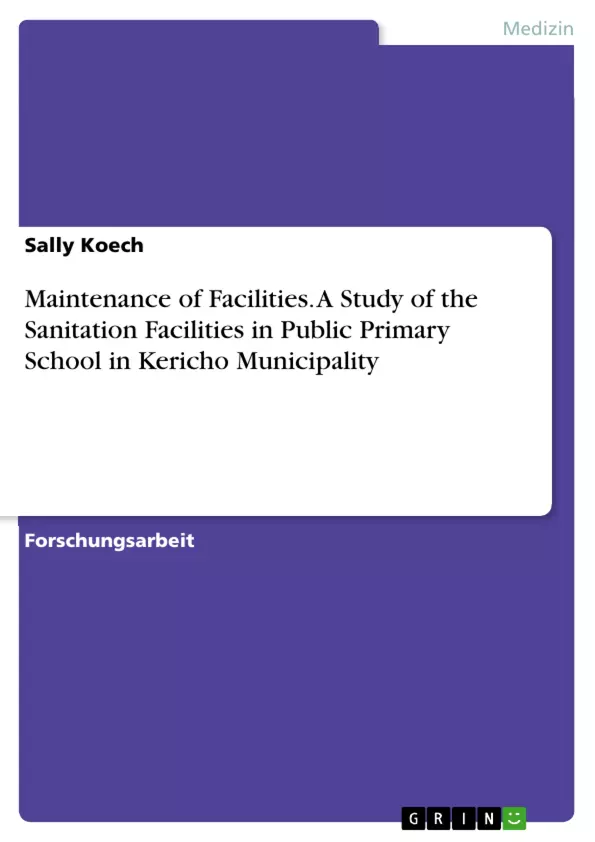Sanitation is a basic human right as ratified by most countries of the world in convection to the rights of a child which states that children have a right to a safe environment that enhance learning, health and development of good citizens. The purpose of the study therefore is to assess the state of hygiene and maintenance of sanitation facilities and to determine if there are any differences in sanitation facilities per gender in public primary schools in Kericho Municipality.
Survey research design was used to assess sanitation facilities in public primary schools. The target population comprised of all standard seven pupils in seventeen (17) public primary schools in Kericho Municipality. A stratified random sampling technique was applied to obtain a sample of 292 standard seven pupils from 5 public primary schools. The sample comprised of 147 boys and 145 girls. Data was collected using questionnaire and observation checklists. The questionnaire was used to collect data from pupils while observation schedules were used by the researcher to collect data from the schools. Data was analysed using frequencies, percentages, means and pie charts.
Inhaltsverzeichnis
- Introduction
- Statement of the Problem
- LITERATURE REVIEW
- RESARCH METHODOLOGY
- The Research Design
- Target Population
- Sample Size and Sampling Procedures
- Data Collection Instruments
- Data Collection Procedures
- Data Analysis and Presentations
- Ethical Considerations
- RESULTS
- CONCLUSION AND RECOMMENDATIONS
- Recommendations
- REFERENCES
Zielsetzung und Themenschwerpunkte
Die Studie zielt darauf ab, den Zustand der Hygiene und Instandhaltung von Sanitäranlagen in öffentlichen Grundschulen in Kericho Municipality zu beurteilen und zu ermitteln, ob es Unterschiede in den Sanitäranlagen nach Geschlecht gibt.
- Bewertung des Zustands der Sanitäranlagen in öffentlichen Grundschulen in Kericho Municipality
- Untersuchung von Unterschieden in den Sanitäranlagen nach Geschlecht
- Analyse des Einflusses von Sanitäranlagen auf die Gesundheit, die schulische Leistung und die Verweildauer von Schülern
- Bewertung der Einhaltung nationaler Standards für Sanitäranlagen in Schulen
- Bedeutung von Hygiene und Instandhaltung für die Förderung einer gesunden und sicheren Schulumgebung
Zusammenfassung der Kapitel
- Introduction: Die Einleitung stellt die Bedeutung von Sanitäranlagen für die Gesundheit, schulische Leistung und Entwicklung von Schülern dar und beleuchtet die Herausforderungen, die durch unzureichende Sanitäranlagen entstehen. Sie befasst sich mit dem Zusammenhang zwischen Sanitäranlagen und dem Auftreten von Krankheiten wie Durchfall und Wurminfektionen.
- Statement of the Problem: Dieses Kapitel identifiziert die Probleme, die im Zusammenhang mit der Instandhaltung von Sanitäranlagen in öffentlichen Grundschulen in Kericho Municipality bestehen. Es beleuchtet die Auswirkungen von Überlastung, unzureichender Ausstattung und mangelnder Finanzierung auf die Sanitäranlagen.
- LITERATURE REVIEW: Dieser Abschnitt analysiert relevante Forschungsergebnisse und Studien zu Sanitäranlagen in Schulen. Er beleuchtet die Bedeutung von WASH-Interventionen (Wasser, Sanitär und Hygiene) für die Verbesserung der Gesundheit und Bildung von Kindern in Entwicklungs- und Industrieländern.
- RESARCH METHODOLOGY: Dieses Kapitel beschreibt die Methoden und Verfahren, die für die Studie angewendet werden, einschließlich Forschungsdesign, Stichprobenumfang, Datenerhebung und Datenanalyse. Es erläutert die verwendeten Fragebögen und Beobachtungsleitfäden sowie die angewandte statistische Analysemethode.
Schlüsselwörter
Die wichtigsten Schlüsselwörter und Schwerpunktthemen der Studie sind: Instandhaltung, Sanitäranlagen, Hygiene, öffentliche Grundschulen, Kericho Municipality, Gesundheit, Schulische Leistung, Verweildauer, Geschlechterunterschiede, nationale Standards, WASH-Interventionen.
- Quote paper
- Sally Koech (Author), 2017, Maintenance of Facilities. A Study of the Sanitation Facilities in Public Primary School in Kericho Municipality, Munich, GRIN Verlag, https://www.grin.com/document/376100



